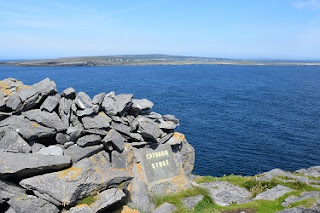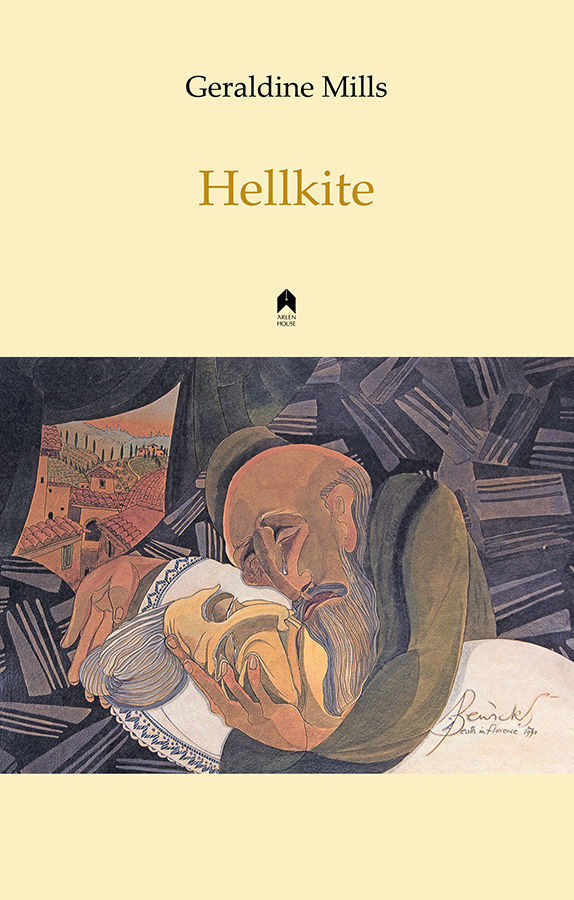The first Éigse Dara Beag will not be its last, such was its huge success this weekend 6-8 October. Inis Meáin, the middle island of the Aran Islands hosted a celebration of their native poet that I am sure would have made him very proud. It was a great privilege for me to be a tiny part of it, having been given the opportunity to read some poems 'as gaeilge'.
I had attended a week-long course there in the summer, staying in Mairtín Cois Cuan's B&B and going to classes in the 'halla'. Coming from a house that had no grounding in the language, I was terrified by it at school but have always loved its intrinsic music.
'Tá sé in am an bád a bhrú amach,' bainisteoir, Ciarán O Cheallaigh said to me when he invited me to read some poems at the celebration. I had no excuse and knew that if I didn't give it a go now I never would. Pushing out the boat was a risk as there was every chance that I would fall out and have to be rescued. Thankfully, that didn't happen. Having to read after the local and established poets was daunting but everyone was very kind and I am delighted to have seized the day. Ciarán's translations are top class and capture perfectly the essence of the work.
The programme was rich and varied from sean-nós singing workshops to lectures on music, to the music itself. It is the very special experience to be able to walk from venue to venue, no need to get into a car. To watch people walking from the old pier or the Dún or the church. Voices carrying sweetly on the blue-skied sunny day. Harp and fiddle in perfect harmony, as the notes flowed out the door of Tigh Chonghaile onto the road, over the stone fields, across the sea that sparkled like a summer's day and anyone on Inis Oirr or the Cliffs of Moher wanting to swim over to be part of it. You had to be there.
My gratitude to Ciarán for all his work and especially the translations which I have copied here. Thanks also for the kindness of everyone I met, especially Mary Fleming and Máirtin for looking after us so well.
Photographs courtesy of Peter Moore.
 |
| Synge's Chair |
.
UAIREANTA SEASANN BEAN SUAS
Uaireanta seasann bean suas
ag an mbord, am dinnéir,
Is siúlann sí amach an leath-dhoras
Is siúlann sí amach an leath-dhoras
Coinníonn sí uirthi
Cé nach bhfuil fhios aici cá bhfuil a ceann scríbe
Is beireann an dorchadas ar an mbóthar
Cé nach bhfuil fhios aici cá bhfuil a ceann scríbe
Is beireann an dorchadas ar an mbóthar
Sula dtiteann an oíche.
Cuireann sí cosc ar na smaointe duairce
Mar a dheineann na réalta le práinn.
SOMETIMES
A WOMAN
after Rilke
Sometimes
a woman
stands
up from the dinner table
and
walks out the half-open door.
She
keeps on going, though
she
doesn’t know where,
and
the road catches darkness
long
before it falls.
Black
thoughts she stills
with
an urgency of stars.
From: Urgency of Stars (Arlen House, 2010)
 |
| The language of stone |
AG BAINT ARÍS
Tháinig sé leis an gclapsholas, an t-inneall bainte,
Nuair a gheall an spéir an saol dos na haoirigh,
Daoine óga dóite ag an ngrian is ag iomrascáil leis an gcodladh.
Tháinig sé ag treabhadh tríd an tost,
Ag stróiceadh suaimhneas na hoíche
Is dhúisigh mo mhac is do sheasamar le chéile
Ag fuinneog an tsamhraidh.
Ag análú an scamall-bholadh chomh milis
Is na lanna ag gearradh don dara uair
Ag réabadh neadacha is áiteacha rúnda
Soilse mar lampróga ag titim na hoíche.
Téim chun tobair lem’bhuicéid
faoin ngealach lán, is rith sé liom
go raibh an speal ar crochadh go ciúin
gan bhrí, is tost an traonaigh timpeall orm.
SECOND CUTTING
It came at twilight, the
silage cutter,
when sky promised the
shepherd’s all,
and little sunburnt
bodies
wrestled with sleep.
It ploughed up curfew’s
silence,
while I, casting off my
bedtime routine
lifted my son from his
sleeping
to stand bewitched at our
summer window.
Clouds of sweetest
smelling became our breathing
from blades that knifed a
second sward.
It tore through nests and
hiding places
Its light – fireflies in
the dimming.
Afterwards with moon
full,
I took my bucket to the
well
With thoughts of the
scythe hanging
Impotent. The corncrake
silent.
From: Unearthing Your Own (Bradshaw Books, 2001)
TORTHAÍ AG TITIM
An mhaidin is atá m'iníon ag fágáil.
Tá sí fós ina codladh suain,
na málaí san halla
is fonn imeachta uirthi.
Tá sí fós ina codladh suain,
na málaí san halla
is fonn imeachta uirthi.
Tá chuile rud pacáilte agamsa
í síol-sparán a cuimhne.
í síol-sparán a cuimhne.
Fágann sí na réalta ar an úrlár dom le scuabadh,
tinte ag titim ón spéir ag seó éigin
Tráth a bhí sí ag lonrach.
tinte ag titim ón spéir ag seó éigin
Tráth a bhí sí ag lonrach.
Sceachóirí ag teacht is rósanna fiáine
ataithe lena bhfuil i ndán dóibh,
úlla ar creathadh faoin solas, ag feitheamh,
tá siad ag foghlaim teanga nua,
conas scaoileadh le rudaí.
úlla ar creathadh faoin solas, ag feitheamh,
tá siad ag foghlaim teanga nua,
conas scaoileadh le rudaí.
Aimseoidh sí a cuid torthaí féin,
piocfaidh sí iad is íosfaidh sí iad
leanfaidh sí an boladh ar an ngaoth.
Is craoibhín beag bídeach mé ag lúbadh.
piocfaidh sí iad is íosfaidh sí iad
leanfaidh sí an boladh ar an ngaoth.
Is craoibhín beag bídeach mé ag lúbadh.
FRUIT FALLING
It is the morning of my daughter's leaving.
It is the morning of my daughter's leaving.
She is still asleep, her cases in the hall eager to be gone
while I have packed all I will
into the seed purse of her memory.
She leaves stars on the floor for me to
sweep up,
sky fires fallen from some show,
some moment when she shone.
Haws ripen, guelder swells with the
future,
apples shiver in the waiting light,
are learning the language of letting
go.
She will find her own fruit, pick and
eat it,
follow its scent on the wind.
I am a small branch bending.
From Toil the Dark Harvest (Bradshaw Books 2003)
 |
| Harry Clarke windows in the church |















